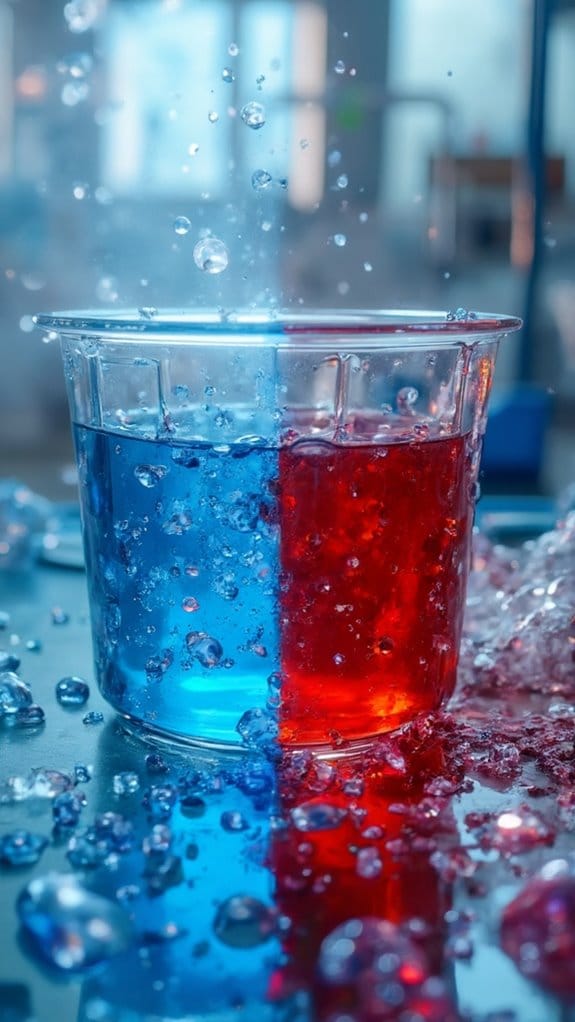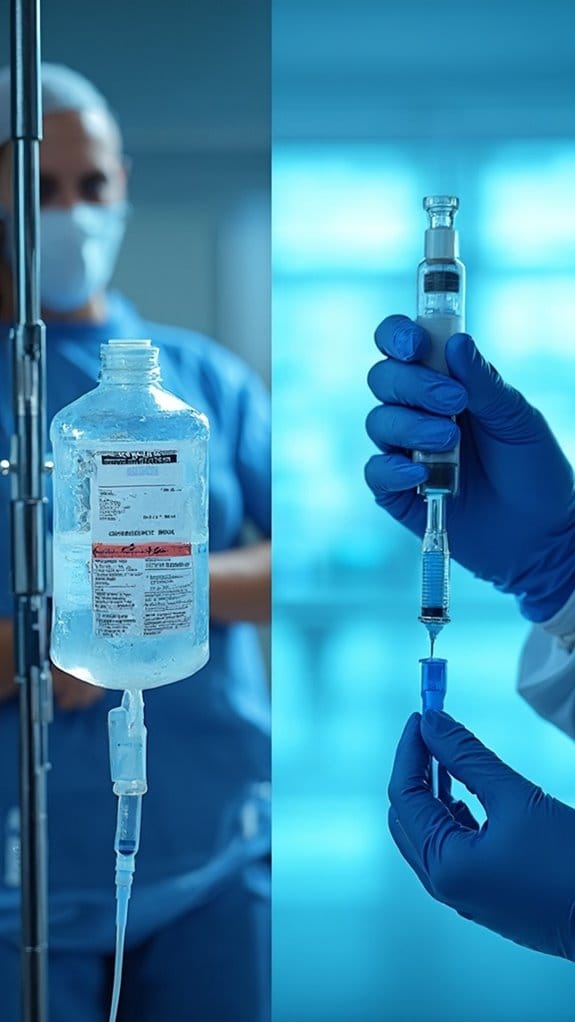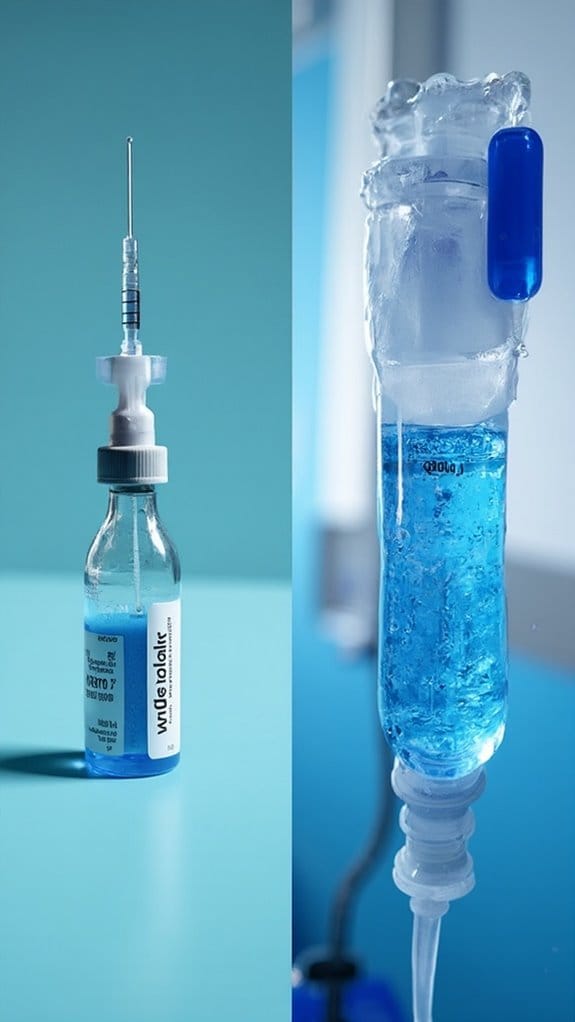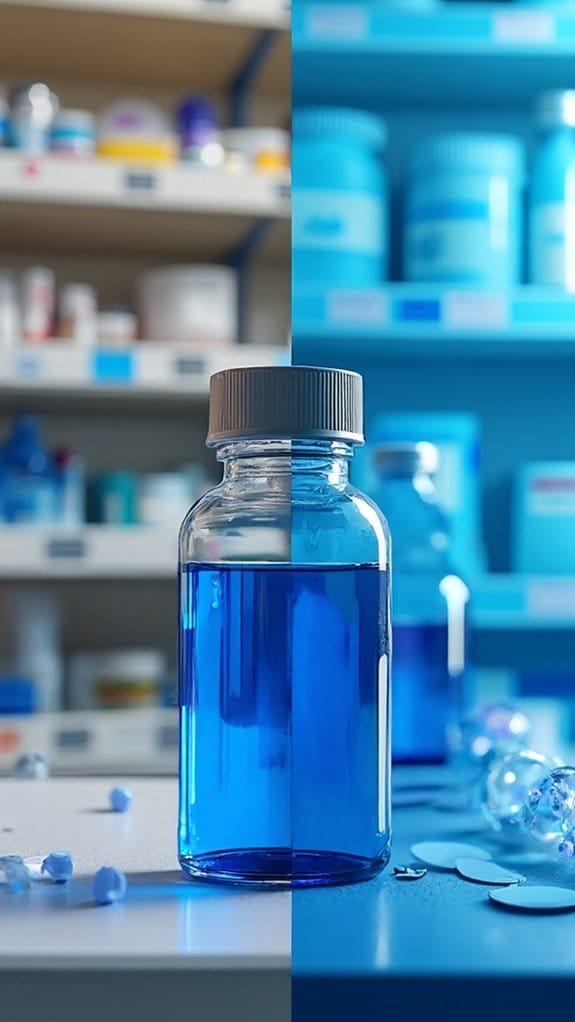Cyanokit and Methylene Blue serve different purposes in emergency care. Cyanokit helps with life-threatening cyanide poisoning by quickly detoxifying cyanide from the body. Meanwhile, Methylene Blue treats methemoglobinemia, which can impair oxygen delivery in the blood. Both have their pros and cons, with Cyanokit often being more expensive but highly effective in its role. Curious about side effects, dosage, and the price difference? Stick around, you'll want to know more about these critical treatments!
Key Takeaways
- Cyanokit is specifically indicated for cyanide poisoning, while Methylene Blue treats methemoglobinemia and enhances oxygen carrying capacity in blood.
- Cyanokit rapidly detoxifies cyanide by binding to it, whereas Methylene Blue converts methemoglobin back to functional hemoglobin.
- Cyanokit may cause side effects like headaches and nausea, whereas Methylene Blue can lead to dizziness and urine discoloration.
- Cyanokit is more expensive, potentially limiting access in emergencies, while Methylene Blue is more affordable and widely available.
- Treatment choice may depend on efficacy, safety, and budget considerations, impacting patient access to timely care.
Overview of Cyanokit and Methylene Blue

When you're faced with a medical emergency, knowing about treatments like Cyanokit and Methylene Blue can be a real game-changer. Cyanokit, primarily used for cyanide poisoning, acts quickly to neutralize the toxic effects of cyanide in your body. Imagine having a lifeline ready when every second counts!
On the other hand, Methylene Blue is a versatile treatment, often used for conditions like methemoglobinemia. It works by helping your blood carry oxygen more effectively. Both treatments have unique applications, so understanding their overviews can empower you. Ever think about how vital it is to be aware of these options?
Whether you're a healthcare professional or just someone who values freedom in choices, knowing your options can make all the difference. It's all about being prepared and informed, right? With both Cyanokit and Methylene Blue, you’re well-equipped to tackle emergencies head-on.
Mechanism of Action

Now that you've got an overview of Cyanokit and Methylene Blue, let’s explore how they work in your body. Ever wonder what happens at the cellular level when you use these treatments? Understanding their mechanisms of action can shine a light on why they’re used for specific conditions, so let’s break it down!
Cyanokit Mechanism Overview
Cyanokit, a lifesaver in cases of cyanide poisoning, works by a pretty fascinating mechanism that’s worth exploring. When you’re exposed to cyanide, it disrupts your body's ability to use oxygen, which is pretty scary, right? Cyanokit uses hydroxocobalamin, a form of vitamin B12, that binds to the cyanide in your bloodstream, forming a harmless compound. This not only helps detoxify your system but also restores your body's oxygen usage.
The benefits of Cyanokit are clear—it acts quickly and efficiently, allowing you to breathe a little easier during a crisis.
Methylene Blue Action Explained
If you’ve ever wondered how Methylene Blue works, you’re in for an intriguing ride. This remarkable compound has a fascinating history, originating in the late 19th century as a dye before finding its medical uses. So, how does it actually function?
Methylene Blue acts primarily by enhancing cellular respiration. It helps restore the balance in your cells when they’re struggling, especially during situations like methemoglobinemia. By converting methemoglobin back to hemoglobin, it boosts oxygen delivery in your body.
It also has antioxidant properties, protecting your cells from damage. Isn't it cool how something once used to color fabric now plays an essential role in medicine?
Understanding Methylene Blue opens up a world of possibilities in treating various conditions.
Clinical Indications

When it comes to treating specific conditions, knowing when to use Cyanokit or Methylene Blue can make all the difference. Have you ever wondered what situations call for each of these treatments? Let's explore the clinical indications for both, along with how they stack up against each other in effectiveness.
Indications for Cyanokit Use
In cases where someone’s been exposed to cyanide, knowing the right treatment can make all the difference. That’s where Cyanokit shines! The indication criteria for using Cyanokit typically involve acute cyanide poisoning, often linked to smoke inhalation or certain industrial accidents. According to clinical guidelines, it's vital to recognize symptoms like confusion, difficulty breathing, or loss of consciousness—these are red flags.
If you’re ever in a situation where cyanide exposure is suspected, quick action matters. You’ll want to guarantee that medical professionals evaluate the situation promptly because timely administration of Cyanokit can be life-saving.
Methylene Blue Applications
Methylene Blue isn’t just a pretty color; it’s a versatile treatment with several important clinical applications. Historically, methylene blue's use dates back to the 19th century, primarily as a dye. But it’s found its way into modern medicine, treating conditions like methemoglobinemia, where it helps restore normal blood oxygen levels.
Ever heard of its role in reducing urinary tract infections? Yep, it does that too! Additionally, methylene blue shows promise in managing certain types of toxic shock. Its ability to enhance mitochondrial function makes it a fascinating option for various conditions.
Comparative Effectiveness Analysis
Considering the diverse applications of methylene blue, it's only natural to wonder how it stacks up against other treatments like Cyanokit. When comparing these two, think about the clinical situations where each shines. Methylene blue isn’t just a treatment; it’s an alternative therapy that has shown promise in various settings. You might find that the effectiveness of methylene blue can lead to improved patient outcomes, especially in specific cases like methemoglobinemia.
But is it always the best choice? Not necessarily. Each treatment has its strengths and limitations, making it essential for you to weigh the options carefully. Understanding these differences can help you make informed decisions about your health or the health of those you care for.
Effectiveness in Treatment

When you're faced with a medical emergency involving cyanide poisoning, you might wonder which treatment option packs the most punch: Cyanokit or Methylene Blue. Both have their strengths, but let’s break down their effectiveness in treatment outcomes.
Cyanokit works by converting harmful cyanide into a harmless substance, and many patients' responses to it are rapid and positive. On the other hand, Methylene Blue can be effective too, especially in cases of methemoglobinemia, but it may not directly address cyanide poisoning as decisively.
Safety and Side Effects

While both Cyanokit and Methylene Blue are used in emergencies, it’s important to evaluate their safety profiles and potential side effects. You want to feel secure when choosing a treatment, right? Cyanokit generally has a favorable safety profile, but some might experience headaches, nausea, or even allergic reactions.
Methylene Blue, on the other hand, can lead to side effects like dizziness, discoloration of urine, or serotonin syndrome in those taking certain medications. This can sound pretty intimidating, but understanding these risks helps you make informed choices.
Dosage and Administration

Getting the right dosage and understanding how to administer Cyanokit and Methylene Blue can feel a bit intimidating, but don’t worry! You’ve got this. For Cyanokit, the recommended dosage is typically 5 grams, administered intravenously over 15 minutes. Simple enough, right?
On the other hand, Methylene Blue’s dosage can vary, usually around 1-2 mg/kg, also given through an IV. It’s essential to follow the dosage guidelines carefully to guarantee effectiveness and safety. Let’s talk about administration routes. Both medications are given intravenously, which means you’ll need a healthcare professional to help with that part.
It’s all about getting the medicine directly into your bloodstream for quick action. So, whether you're facing cyanide poisoning or methemoglobinemia, knowing how to administer these treatments can empower you.
Comparison of Cost and Accessibility

After understanding how to properly administer Cyanokit and Methylene Blue, it’s time to reflect on another important aspect: the cost and accessibility of these treatments. Let’s face it—if you’re in a tight spot, knowing what you can afford makes all the difference! A cost analysis reveals that Cyanokit often comes with a heftier price tag, which can lead to accessibility issues, especially in emergency situations.
On the flip side, Methylene Blue tends to be more budget-friendly, making it a more accessible option for many. But what if you need immediate help? If you can’t find the treatment you need due to cost or availability, it’s a tough situation.
Frequently Asked Questions
Can Cyanokit and Methylene Blue Be Used Together?
You might wonder if Cyanokit and methylene blue can be used together. While they both tackle serious conditions, their compatibility isn’t straightforward. Some studies suggest they mightn't work well in tandem, potentially reducing each other's effectiveness.
Think about it: do you really want to risk that synergy? Always consult a healthcare professional before mixing treatments. Your health deserves careful consideration and the best possible care, don’t you think?
Are There Any Known Drug Interactions With These Treatments?
When it comes to drug interactions, you’ve gotta be careful! Both treatments can affect drug metabolism, leading to unexpected interaction mechanisms. For instance, if you’re taking other medications, they might not work as intended.
Ever wonder how certain drugs can compete for the same pathways? It’s like a traffic jam in your body! Always chat with your healthcare provider before mixing treatments, ensuring you stay safe and informed on what’s happening inside you.
How Quickly Do These Treatments Act in Emergencies?
When emergencies strike, you want your response to be as swift as a cheetah on the hunt! Both treatments have a quick treatment onset, but they act differently. In urgent situations, Cyanokit can work within minutes to counteract cyanide toxicity, while Methylene Blue typically takes a bit longer.
Isn’t it reassuring to know that every second counts? Knowing these nuances can help you make informed decisions when time is of the essence!
Are There Specific Populations That Should Avoid These Treatments?
When it comes to specific populations, you should consider pregnancy and pediatric patients. Pregnant women might face risks from certain treatments, so it’s best to consult a healthcare professional. Pediatric patients, being more vulnerable, mightn't respond the same way as adults.
Isn’t it important to guarantee safety for everyone? Always think critically about who’s getting treated and weigh the risks. After all, a little caution goes a long way, right?
What Are the Long-Term Effects of Using These Medications?
When you consider the long-term effects of certain medications, it’s essential to think about medication dependency. You might find that prolonged use can lead to some unexpected side effects, like fatigue or cognitive changes. Have you ever wondered how these could impact your daily life?
While these medications can be lifesaving, it’s vital to weigh the benefits against potential drawbacks. Staying informed helps you make the best choices for your health and freedom!
Conclusion
In the battle of Cyanokit versus Methylene Blue, think of them as different heroes in the same quest against toxicity. While Cyanokit is your go-to for cyanide poisoning, Methylene Blue shines in treating methemoglobinemia. Each has its strengths and weaknesses, like two sides of a coin, and knowing when to use them is key. So, whether you're facing a villainous toxin or just curious about treatments, understanding these options can empower your choices. Which hero will you choose?
